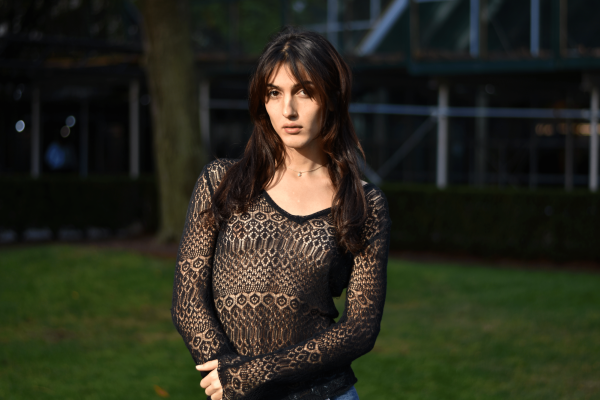It’s a bird, it’s a plane, it’s a college student dressed up in a rhinoceros costume. “Rhinoceros,” directed by Asa Nestlehutt, Fordham College at Lincoln Center (FCLC) ’24, premiered in Kehoe Studio Theatre on Nov. 14 as one of Fordham Theatre’s best-dressed productions of the semester.
Nestlehutt’s thesis project “Rhinoceros” boldly challenges the boundaries of absurdism and avant-garde theater. Written by Eugène Ionesco in 1959, the play is a Kafkaesque comedy that serves as a critique of human nature and conformity by depicting the cast of characters slowly turning into rhinoceroses.
The story follows Berenger (Jack Clark, FCLC ’25) the only sane man — who happens to be a drunkard — in a town descending into madness as members of the community begin to transform into rhinoceroses. Clark gives a hilarious performance and serves as a brilliant audience insert character.
Flashing lights reveal the ensemble cast, their faces painted clown white, adorned in iconic costumes and striking frozen tableaus on the stage.
Flashing lights reveal the ensemble cast, their faces painted clown white, adorned in iconic costumes and striking frozen tableaus on the stage. Designed by Peter Chan, FCLC ’24, the wardrobe was heavily inspired by the early 1960s and expertly placed the characters into the period.
The costumes drive the show and truly become a plot device in their own right, rather than a mere accessory. Chan noted that they collaborated with Nestlehutt to bring a Wes Anderson influence to the costumes, which meant bright and identifiable colors for each character.
White curtains mask the back and sides of the stage, allowing the cast to slip out of view, leaving Berenger and his friend Jean (Milagros Luis, FCLC ’25) alone in a cafe. Daisy (Riley Halpern, FCLC ’25), a girl in the town for whom Berenger has romantic feelings, appears in the cafe among other townspeople. Jean makes fun of Berenger for his feelings and says that Daisy could never love him because of his drinking problem; the two begin to argue.
Their outfits are head-to-toe black suits scattered with numerous large horns that perfectly compliment the surreal and absurd motifs of the play.
In a moment, the cafe erupts into disbelief and chaos when the characters spot a rhinoceros storming through the street outside. The townspeople huddle together in front of the cafe window and begin a hilarious — yet heated — debate about the number of horns and species of the rhinoceros seen outside. After another rhinoceros encounter, the seemingly small argument descends into an all-out fight between Berenger and Jean.
Rhinoceros encounters begin to occur more frequently and townspeople begin to disappear, but the audience isn’t clued in on the correlation until Mrs. Boeuf (Anne Lois Bullington, FCLC ’26) recognizes a rhinoceros as her husband, leading her to jump out of a window onto its back. The scene is a tremendous feat, and Bullington’s performance is hysterical, making it one of the most memorable scenes of the play.
Berenger goes to Jean’s apartment to apologize for the earlier fight in the cafe and finds Jean slightly sick. Jean’s condition worsens throughout the conversation and he ruthlessly criticizes Berenger and his lifestyle. The scene takes a surrealist turn as Jean begins to transform into a rhinoceros in front of Berenger and the audience.
The transformed rhinoceroses tear down the curtains from behind, showing themselves on stage for the first time and leaving the audience aghast. Their outfits are head-to-toe black suits scattered with numerous large horns that perfectly compliment the surreal and absurd motifs of the play.
Chan highlighted that the inspiration behind the costumes came from abstract art.
“Looking at research images and abstract paintings, I was pointed toward adding more horns as if these people are growing the horns themselves, as if them turning into rhinoceroses was not a natural thing,” they said.
As the play draws to a close, Berenger and Daisy are the last two people who haven’t transformed, and they profess their love for one another. Daisy, however, begins to succumb to the change, choosing community and evolution over love and leaving Berenger alone. Halpern delivers a heartbreaking and beautiful portrayal of the transformation.
Berenger resists the transformation and ends the show as a testament to nonconformity and personal identity.
“Rhinoceros” perfectly balanced a witty comedic show with profound social commentary dazzling audiences and leaving them talking. The play was wild and whimsical, but most of all a triumphant success.


